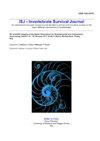Encapsulation and nodulation in insects
IF 1.2
4区 农林科学
Q4 IMMUNOLOGY
引用次数: 76
Abstract
Evolution of the insect immune system led to the creation of a comprehensive cellular defensesystem, not only involving phagocytosis, but also encapsulation and nodulation (both often referred to as capsule formation) allowing the isolation and neutralization of invading pathogens and parasites. Such reactions are closely related to the anatomical and physiological characteristics in insects with their external skeleton and open circulatory blood system. Encapsulation and nodulation are most important defense mechanisms in insects, as they allow targeting of the immune response to the site of damage to quickly destroy the intruder. Host penetration results in both the production of damageassociated molecular patterns (DAMPs) and to the presence of pathogen-associated molecular patterns (PAMPs) in the hemolymph. Subsequent signal induction occurs by host pattern recognition receptors (PRRs) and other systems. Capsule formation results from aggregation and partialdisruption of the hemocytes on the target surface resulting in melanization by the proPO cascade. Reactive oxygen (ROS) and nitrogen (RNS) species are emitted during melanogenesis and targeted against the invader. As a result, the intruder is not only isolated within the capsule but also destroyed. Insects have a number of systems (serpins, antioxidants), aimed at the regulation of melanogenesis and inactivation of toxic products resulting from melanization. All these complex mechanisms allow rapid and effective detection, isolation and destruction of invaders with minimal damage to the insect.昆虫的包壳和结瘤
昆虫免疫系统的进化导致了一个全面的细胞防御系统的产生,不仅包括吞噬作用,还包括包封和结瘤(两者通常被称为胶囊形成),允许隔离和中和入侵的病原体和寄生虫。这些反应与昆虫外骨骼和开放循环血液系统的解剖生理特性密切相关。包封和结瘤是昆虫最重要的防御机制,因为它们允许免疫反应靶向损伤部位,迅速摧毁入侵者。宿主渗透导致损伤相关分子模式(DAMPs)的产生和病原体相关分子模式(PAMPs)在血淋巴中的存在。随后的信号诱导由宿主模式识别受体(PRRs)和其他系统发生。胶囊的形成是由于靶表面血细胞的聚集和部分破坏,导致丙二酚级联的黑化。活性氧(ROS)和氮(RNS)物质在黑色素形成过程中释放,并针对入侵者。结果,入侵者不仅被隔离在太空舱内,而且被摧毁。昆虫有许多系统(蛇形蛋白,抗氧化剂),旨在调节黑色素形成和由黑色素化引起的有毒产物的失活。所有这些复杂的机制都可以快速有效地检测、隔离和消灭入侵者,同时对昆虫造成最小的伤害。
本文章由计算机程序翻译,如有差异,请以英文原文为准。
求助全文
约1分钟内获得全文
求助全文
来源期刊

ISJ-Invertebrate Survival Journal
IMMUNOLOGY-ZOOLOGY
CiteScore
2.10
自引率
0.00%
发文量
0
审稿时长
>12 weeks
期刊介绍:
Invertebrate Survival Journal (ISJ) is an international and open access journal devoted to prompt and innovative studies on the basic defense mechanisms in invertebrates, in particular with a view to identifying biotechnologies able to act against derived diseases and related economic damage.
Contributions will be mainly in the form of Letters to the Editor, Visions and Perspectives, Short Communications, Technical Reports, Research Reports, Review, Minireview and Reports of Meetings. Letters to the Editor can be commentaries or perspectives on invertebrate defence mechanisms or replies to the data published in ISJ.
 求助内容:
求助内容: 应助结果提醒方式:
应助结果提醒方式:


